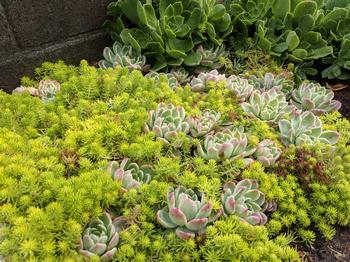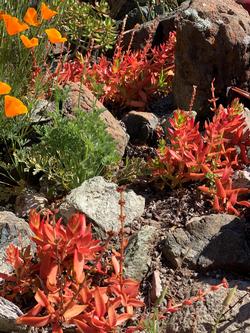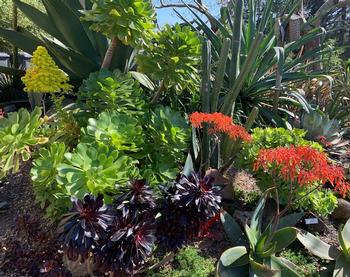Success with Sensational Succulents
-
Anne-Marie Walker
-
With over 10,000 species of succulents and many more hybrids introduced every year, there is a succulent to suit any garden design or solar orientation. There are succulent ground covers, background shrubs, eye-catching starlets and very large tree forms. Many exhibit sensational characteristics just right for Marin gardens. What better time than now to introduce low water use plants into our gardens and “do a little bit of good in the world.”
 Sedum repestre ‘Angelina’, Echeveria elegans and Aeonium decorum form a border of lovely contrasting colors. Photo: Lillian Trac
Sedum repestre ‘Angelina’, Echeveria elegans and Aeonium decorum form a border of lovely contrasting colors. Photo: Lillian TracSpring and fall are the best times to plant succulents. Temperature swings have evened out and new plants have time to spread their roots. UC Marin Master Gardeners have been propagating and growing succulents at Falkirk Cultural Center in San Rafael for the Big Outdoor Succulent Sale on Saturday, May 22, 2021 from 8 am to 11am. The public is invited to attend wearing a mask and socially distancing to purchase succulents with either cash or check only. Fun and artfully arranged succulent planters will also be available. For more information on succulents as well as a list of succulents for sale, go to www.marinmg@ucanr.edu.
Success in growing succulents is best achieved by understanding their growth habits. For most succulents, this means keeping their roots dry. Plant in soil that has been combined with porous materials like lava rock, pumice or even compost. As most soil in Marin is clay, succulents planted in a raised mound help to ensure drainage. Place the more water tolerant succulents at the base of the mound and the more water sensitive succulents at the top of the mound. While all succulents are from dry regions of the world, those from Mediterranean climates grow in winter and are dormant in summer. This includes aeoniums, aloes, crassulas, kalanchoes and sedums. Succulents from other dry regions including Australia, the Arabian Peninsula and the deserts of Argentina, Arizona and Mexico grow in summer and are dormant in winter. Summer-growers include agaves, echeverias and sempervivums.
Succulents store water in thickened leaves, stems and roots. Recent scientific research concludes succulents adapted to store water in their leaves with an evolutionary third vein; other leaves have two veins. These thickened leaves are frequently arranged in spiraling, pleasing rosettes. Each of the succulents for sale by UC Marin Master Gardeners at the Big Outdoor Succulent Sale has a sensational feature. Sedums, perhaps the most widely distributed succulent throughout the world, mix well planted with other small succulents. Known for their sensational colorful foliage ranging from chartreuse, blue-green, and even burgundy, sedums can be an exciting pop in the landscape. Aloe arborescens, a tree aloe, can grow to 10 feet and blooms in winter attracting hummingbirds and bees when few other plants are in flower. Its red orange flowers are sensational, recalling a candelabra or torch. Several Crassulas (Jade) family will be offered including Crassula capitella ‘Campfire’. Plump succulent leaves all store water but ‘Campfire’s’ leaves do something sensational. To make food for the plant, the leaf gathers energy from the sun through stoma (openings). Crassulas adapted an interesting metabolism that allows them to collect moisture at night. ‘Campfire’ leaves turn flashy orange for protection from UV damage during the day. The plump orange leaves of the 'Campfire' jade plant protect from harmful UV rays. Photo: David S. Walker
The plump orange leaves of the 'Campfire' jade plant protect from harmful UV rays. Photo: David S. Walker The burgundy leafed Aeonium arboretum 'Zwartkop' is planted at Falkirk Cultural Center in San Rafael. Photo: David S. Walker
The burgundy leafed Aeonium arboretum 'Zwartkop' is planted at Falkirk Cultural Center in San Rafael. Photo: David S. Walker
Another sensational succulent is Aeonium arboreum ‘Zwartkop’ whose architecturally ornate symmetrical form fits in any garden. This dark burgundy succulent pairs well with Senecio mandrelascae ‘Blue Chalk Sticks’ which is also for sale. Lots of hybrid succulents have appeared recently including Graptoveria ‘Fred Ives’ whose sensational color ranges from orange to bronze to lilac. Succulents bring unsurpassed beauty to our gardens. Don’t miss the Big Outdoor Succulent Sale, May 22, 2021 from 8am to 11am at Falkirk Cultural Center in San Rafael and dig into the world of succulents.



